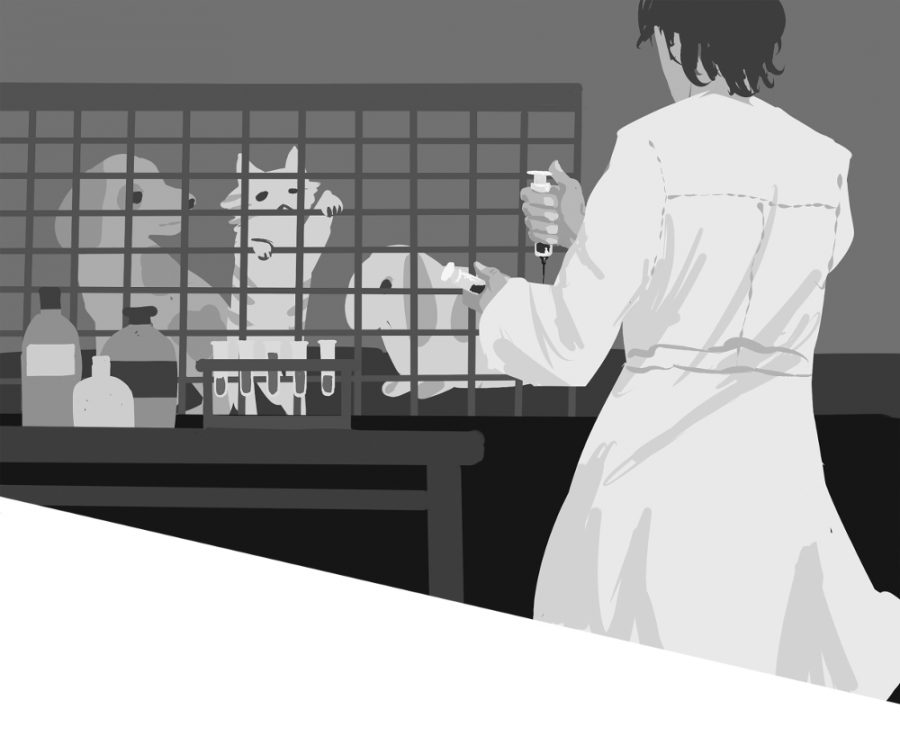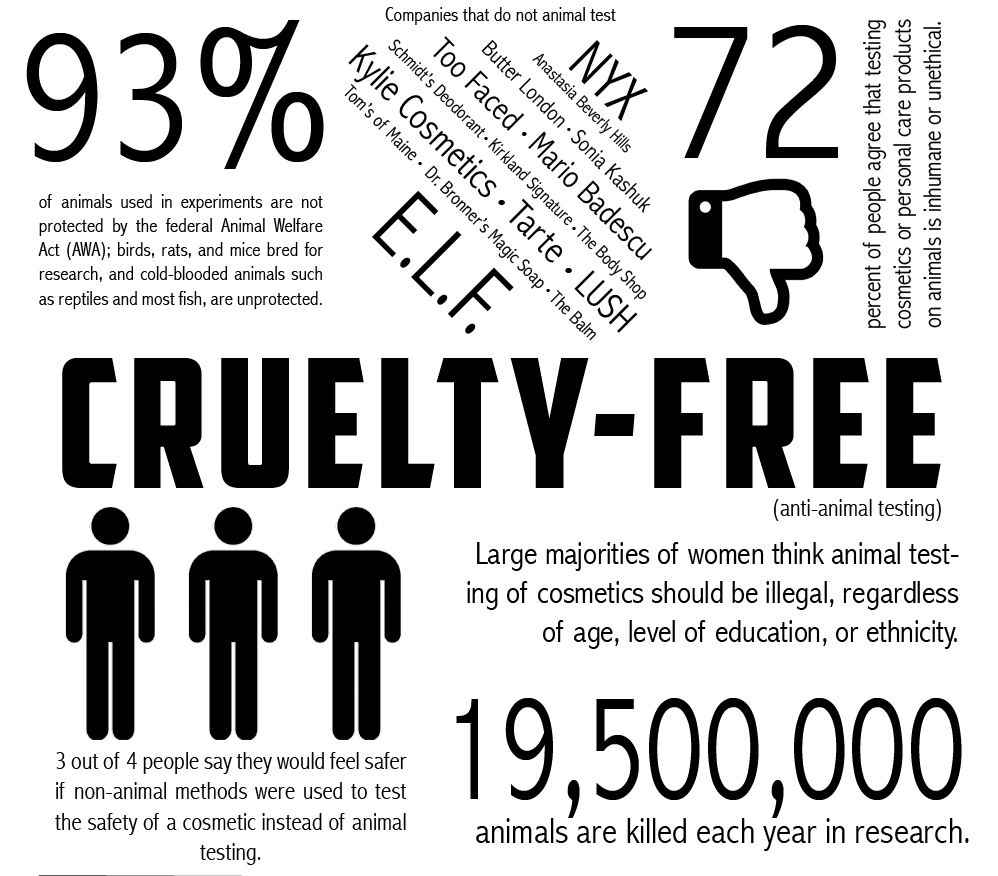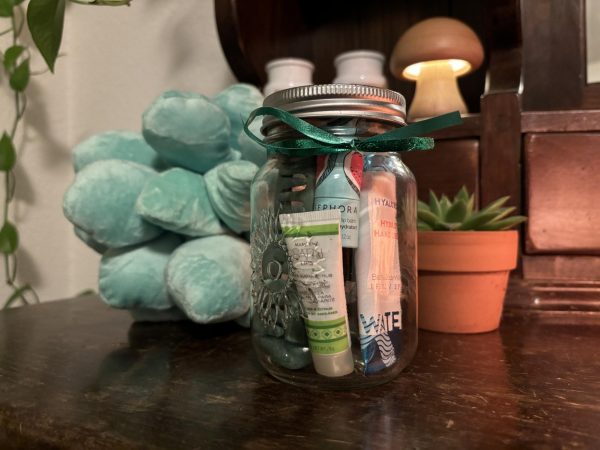Animal Testing: Things a conscientious buyer should be aware of
Photo by Jessica Tang
Walk into the average makeup, grocery, or drug store and take a look around: there are hundreds of brands and products lining the shelves. How do you know which one to choose? How is your choice influenced? Is it by the positive effects the label promises or the popularity of the brand name? All of these seem to be the usual questions people ask when they choose what to buy, but a larger, deeper, and mainly avoided question is often overlooked –– does this product test on animals? For some, this answer plays a part in their purchasing options, but many have no clue the brands they are using test on animals. Regardless, the history, legality, and morality of animal testing has been a debate long discussed all around the world.
Animal testing is not illegal in the United States, but is in other parts of the world; some countries ban the testing on certain animals, but still allow testing on others. According to the Animal Legal Defense Fund, “…an estimated 100 million animals are exploited in biomedical, aeronautic, automotive, military, agricultural, and cognitive research and in consumer product testing — 95% of these animals are not protected by the law.”
The United States is one of only two countries in the world whose government openly allows it. As of 2013, no animals may be used in cosmetic testing in the European Union in accordance to E.U. regulations. So while the use of animal testing may be not be illegal in the U.S., there are some laws regarding the management of the animals.
The Animal Welfare Act, which monitors how animals for research are handled, states that “federal law in the United States regulates the treatment of animals in research, exhibition, transport, and by dealers. Other laws, policies, and guidelines may include additional species coverage or specifications for animal care and use, but all refer to the Animal Welfare Act as the minimum acceptable standard.”
Essentially the Animal Welfare Act is the umbrella law controlling all animal testing. Sophomore Chris Sachen voices his opinion on the testing of animals and how this information influences his decisions when buying products.
“If they treat [the animals] badly then that would definitely affect my decision to use the product in a negative way. If they took care of the animals when they tested them, and it wasn’t animal cruelty, then I would be fine using it,” said Sachen.
Canadian-American actress and former M.A.C. spokesperson Pamela Anderson spoke out in a letter to Estée Lauder’s group president John Demsey (Estée Lauder owns MAC) about how upset she was over the fact that the company tested on animals.
“When I worked with M.A.C., I found it to be a very progressive and forward-thinking company. That’s why I was very disturbed to learn from PETA that M.A.C., under your direction at Estée Lauder, is selling products in China where the company funds painful tests on animals in order to meet the country’s archaic regulations. This has tainted the brand and alienated many of the company’s longtime allies,” said Anderson.
Freshman Cailyn Hilliard generally seeks out products free from animal testing and questions why bigger companies with expensive products (like MAC) test on animals.
“Usually I check and make sure [the brands] don’t test on animals because it’s really bad. It’s terrible for animals; they’re used against their will. Since [expensive cosmetic companies] have so much money, they should find another way to test, and I don’t feel that they should test on animals –– it’s just bad,” said Hilliard.
Some people suggest that alternative testing should be on humans who can give their verbal consent and know what is being done to them or can opt out of the tests if they want to.
“If [people] are willing [to be tested on], then of course. They feel that the humans’ lives are worth more than the animals’ lives, but that’s not necessarily true –– they are both equal,” said Sachen.
Various animal rights organizations, like PETA and Cruelty Free International, express the message that not only is it cheaper to not test on animals, but there are plenty of alternatives. One alternate slowly making its way into mainstream practices is the use of human tissues.
The New York Times writes, “The goal is not to patch up ailing people but to use the human tissues in place of mice, dogs or other lab animals for testing new drugs, cosmetics and other products. The methods for engineering tissue samples are among the most complex of an expanding portfolio of technologies intended to eliminate or reduce animal testing.”
Besides testing subjects physically by engineers, electronic programs have begun to be used. This way, no test subject (person or animal) gets hurt or compromised in the process of testing due to negative side effects, chemical reactions, etc. “In other cases, testing is being conducted virtually, using computers and simulation software. And for some tests, people have replaced animals: volunteers get microdoses of potential drugs that can be analyzed but cause no ill effects” (New York Times).
The debate on animal testing has been argued for decades. While some see perks in the fact that no humans are harmed, others suggest that updates in technology have created alternative methods that neither impair nor sacrifice animals. Moreover, there are so many options at the store to choose from whether you are specifically looking for a non-animal tested product or not. To know whether or not an item you are interested in is animal cruelty-free and/or vegan, just look for a symbol most commonly in the shape of a bunny. Next time you walk into a store and find yourself surrounded by a plethora of brands and products, be a conscious shopper and choose the one you feel works best for your needs.
Information compiled by Lauren Gonzales.














